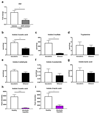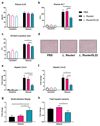Bacteria engineered to produce IL-22 in intestine induce expression of REG3G to reduce ethanol-induced liver disease in mice
- PMID: 30448775
- PMCID: PMC6387784
- DOI: 10.1136/gutjnl-2018-317232
Bacteria engineered to produce IL-22 in intestine induce expression of REG3G to reduce ethanol-induced liver disease in mice
Abstract
Objective: Antimicrobial C-type lectin regenerating islet-derived 3 gamma (REG3G) is suppressed in the small intestine during chronic ethanol feeding. Our aim was to determine the mechanism that underlies REG3G suppression during experimental alcoholic liver disease.
Design: Interleukin 22 (IL-22) regulates expression of REG3G. Therefore, we investigated the role of IL-22 in mice subjected to chronic-binge ethanol feeding (NIAAA model).
Results: In a mouse model of alcoholic liver disease, we found that type 3 innate lymphoid cells produce lower levels of IL-22. Reduced IL-22 production was the result of ethanol-induced dysbiosis and lower intestinal levels of indole-3-acetic acid (IAA), a microbiota-derived ligand of the aryl hydrocarbon receptor (AHR), which regulates expression of IL-22. Importantly, faecal levels of IAA were also found to be lower in patients with alcoholic hepatitis compared with healthy controls. Supplementation to restore intestinal levels of IAA protected mice from ethanol-induced steatohepatitis by inducing intestinal expression of IL-22 and REG3G, which prevented translocation of bacteria to liver. We engineered Lactobacillus reuteri to produce IL-22 (L. reuteri/IL-22) and fed them to mice along with the ethanol diet; these mice had reduced liver damage, inflammation and bacterial translocation to the liver compared with mice fed an isogenic control strain and upregulated expression of REG3G in intestine. However, L. reuteri/IL-22 did not reduce ethanol-induced liver disease in Reg3g-/- mice.
Conclusion: Ethanol-associated dysbiosis reduces levels of IAA and activation of the AHR to decrease expression of IL-22 in the intestine, leading to reduced expression of REG3G; this results in bacterial translocation to the liver and steatohepatitis. Bacteria engineered to produce IL-22 induce expression of REG3G to reduce ethanol-induced steatohepatitis.
Keywords: ILC; immune response; metabolome; microbiome.
© Author(s) (or their employer(s)) 2019. No commercial re-use. See rights and permissions. Published by BMJ.
Conflict of interest statement
Competing interests: None declared.
Figures







Similar articles
-
Oral administration of PEGylated TLR7 ligand ameliorates alcohol-associated liver disease via the induction of IL-22.Proc Natl Acad Sci U S A. 2021 Jan 5;118(1):e2020868118. doi: 10.1073/pnas.2020868118. Epub 2020 Dec 21. Proc Natl Acad Sci U S A. 2021. PMID: 33443222 Free PMC article.
-
Enteric dysbiosis associated with a mouse model of alcoholic liver disease.Hepatology. 2011 Jan;53(1):96-105. doi: 10.1002/hep.24018. Epub 2010 Dec 10. Hepatology. 2011. PMID: 21254165 Free PMC article.
-
Gut microbiota metabolite indole-3-acetic acid maintains intestinal epithelial homeostasis through mucin sulfation.Gut Microbes. 2024 Jan-Dec;16(1):2377576. doi: 10.1080/19490976.2024.2377576. Epub 2024 Jul 27. Gut Microbes. 2024. PMID: 39068517 Free PMC article.
-
From intestinal dysbiosis to alcohol-associated liver disease.Clin Mol Hepatol. 2020 Oct;26(4):595-605. doi: 10.3350/cmh.2020.0086. Epub 2020 Sep 11. Clin Mol Hepatol. 2020. PMID: 32911590 Free PMC article. Review.
-
Alcoholic liver disease: the gut microbiome and liver cross talk.Alcohol Clin Exp Res. 2015 May;39(5):763-75. doi: 10.1111/acer.12704. Alcohol Clin Exp Res. 2015. PMID: 25872593 Free PMC article. Review.
Cited by
-
Microbiota-Dependent Effects of IL-22.Cells. 2020 Sep 29;9(10):2205. doi: 10.3390/cells9102205. Cells. 2020. PMID: 33003458 Free PMC article. Review.
-
Novel Immune Subsets and Related Cytokines: Emerging Players in the Progression of Liver Fibrosis.Front Med (Lausanne). 2021 Apr 1;8:604894. doi: 10.3389/fmed.2021.604894. eCollection 2021. Front Med (Lausanne). 2021. PMID: 33869241 Free PMC article. Review.
-
Role of the type 3 cytokines IL-17 and IL-22 in modulating metabolic dysfunction-associated steatotic liver disease.Front Immunol. 2024 Aug 2;15:1437046. doi: 10.3389/fimmu.2024.1437046. eCollection 2024. Front Immunol. 2024. PMID: 39156888 Free PMC article. Review.
-
Microbial Tryptophan Metabolites Ameliorate Ovariectomy-Induced Bone Loss by Repairing Intestinal AhR-Mediated Gut-Bone Signaling Pathway.Adv Sci (Weinh). 2024 Sep;11(36):e2404545. doi: 10.1002/advs.202404545. Epub 2024 Jul 23. Adv Sci (Weinh). 2024. PMID: 39041942 Free PMC article.
-
Modulating phenylalanine metabolism by L. acidophilus alleviates alcohol-related liver disease through enhancing intestinal barrier function.Cell Biosci. 2023 Feb 4;13(1):24. doi: 10.1186/s13578-023-00974-z. Cell Biosci. 2023. PMID: 36739426 Free PMC article.
References
-
- Rehm J, Samokhvalov AV, Shield KD. Global burden of alcoholic liver diseases. J Hepatol. 2013;59:160–8. - PubMed
-
- Llopis M, Cassard AM, Wrzosek L, Boschat L, Bruneau A, Ferrere G, et al. Intestinal microbiota contributes to individual susceptibility to alcoholic liver disease. Gut. 2016;65:830–9. - PubMed
-
- Mukherjee S, Hooper LV. Antimicrobial defense of the intestine. Immunity. 2015;42:28–39. - PubMed
Publication types
MeSH terms
Substances
Grants and funding
LinkOut - more resources
Full Text Sources
Other Literature Sources
